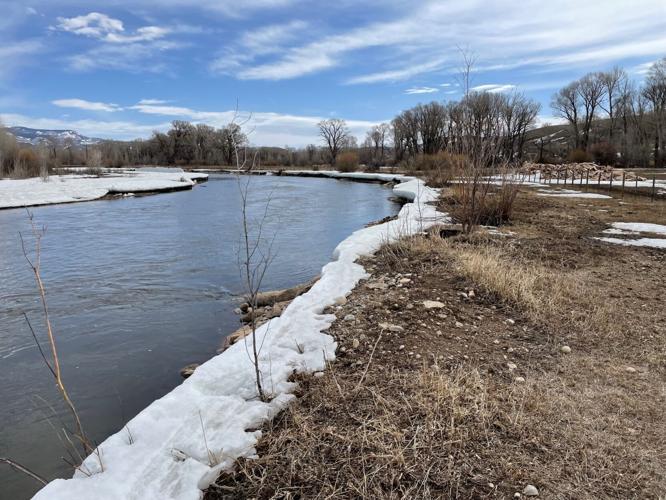The mighty Colorado River just got a blow to its reputation: The nation’s sixth longest waterway, which winds through seven Southwest states and provides drinking water for 40 million people, is the most endangered river in the country.
American Rivers, a national conservation organization, crowned the Colorado River with the unwelcome designation Monday, blaming climate change-driven heat and drought, combined with outdated river management and overallocation of limited water supplies.
Colorado River Towns: The story of Colorado as reflected in its water, its people, and its future
“The eyes of the world have been on the river and now we are in the crisis that we feared for years,” said Matt Rice, American Rivers’ Southwest regional director. “People on Denver’s Front Range don’t understand this crisis. They turn on the faucet and water comes out. ... But ranchers can’t get water to irrigate. We need to use less water to live with the river that we have.”
The Colorado River Basin is home to 30 native fish species, many of which are threatened. More than 400 bird species depend on the area as well. The 1,450-mile river provides water for Denver, Los Angeles, Phoenix and Las Vegas. Unlike Colorado’s other rivers, it touches all four corners of the state.
Rancher Paul Bruchez, his dad and his brother moved their families from Westminster to Kremmling in 2000 with a dream of ranching in the mountains. They bought the 6,000-acre Reeder Creek Ranch in part because the Colorado River runs through it. For a couple of glorious years, all was flowing according to plan: The Rocky Mountain snowpack fed the river, the fish were thriving and the crops grew tall. But when the drought of 2002 hit, the snowmelt was around half of where it was supposed to be and warm temperatures made things worse, quickening the thaw so that runoff didn’t last very long.
Western US scrambles to secure water supplies as it faces historic drought
That year, Bruchez could walk across the river in places and see the fish going belly up in the warm water.
“Come 2003, my family had a meeting. We wondered, did we move to the wrong place? Instead of leaving, we decided to adapt and adjust to the river flow, climate change and population growth,” Bruchez told The Denver Gazette.
Seeing no quick fix, Bruchez established a restoration project and a Colorado Basin roundtable and prepared to go along for the ride.
Over time, Bruchez’s projects have led to water savings and recovery.
“We are discovering different types of plants, which are more drought-resilient. I want to make a bumper sticker which says, 'Not all perennials are created equal,'” Bruchez said with a laugh.
Bruchez and Rice are sounding the alarm about the shrinking Colorado River as loudly as they can, hoping residents on the Front Range hear their message. They are disappointed that cities have not implemented water restrictions.
“They turn on the faucet and water comes out. People need to understand the connection between how we use water here and the effects and impacts on the West Slope,” said Rice.
Bruchez said it may come down to a choice of green lawns along the Front Range and food production. He is begging Coloradans to get on board the water-saving train, he says, because “too late” is now.
“This is happening today. If we don’t act immediately, we will find ourselves in a crisis,” said Bruchez. “We are running out of water and we are running out of time.”
Snowmelt from Colorado and Wyoming that trickles into the Colorado River and feeds Lake Powell is crucial, and so is the timing of when it starts to flow. Each year in the last two decades of drought, more of the bathtub ring along the red cliffs of America’s second-largest reservoir has become uncovered as the water level lowers. The latest numbers show Lake Powell at 3,523 feet above sea level, considered the warning level for people who keep up with these statistics. It’s the first time the reservoir has ever sunk that low. Water in Lake Mead is also at record lows.
After a healthy March, snowpack levels are at 93% of average, according to the Colorado Snow Survey, but the National Weather Service is predicting warm weather and lower-than-normal levels of precipitation this month.
When the Bruchez ranch got 2½ feet of snow in March, it was like frozen white gold, Bruchez said. But the thirsty ground soaked that up quickly, meaning there was little runoff.
“The snow seeped right into the ground. There have been so many years of dryness, the grounded needed it. I don’t know what it’s going to take to catch up,” said Bruchez.
Rice said the second- and third-most endangered rivers in the U.S. are the Snake River in Idaho, Washington and Oregon, which American Rivers says is threatened by four federal dams, and Alabama’s Mobile River, which is hampered by coal ash contamination.
Western US scrambles to secure water supplies as it faces historic drought
"If you want to make a difference, water 30% less in your yards, get involved in how city households can conserve water, protect your open spaces," said Bruchez. "This is all for one and one for all. Or we all lose."
Correction: The headwaters of the Colorado River are in Rocky Mountain National Park. A previous version of this story misstated where the river begins.











(0) comments
Welcome to the discussion.
Log In
Keep it Clean. Please avoid obscene, vulgar, lewd, racist or sexually-oriented language.
PLEASE TURN OFF YOUR CAPS LOCK.
Don't Threaten. Threats of harming another person will not be tolerated.
Be Truthful. Don't knowingly lie about anyone or anything.
Be Nice. No racism, sexism or any sort of -ism that is degrading to another person.
Be Proactive. Use the 'Report' link on each comment to let us know of abusive posts.
Share with Us. We'd love to hear eyewitness accounts, the history behind an article.